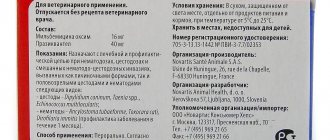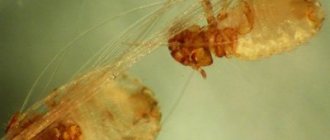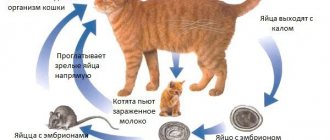What does a lice eater look like?
The cat lice beetle (Felicola subrostratus) is a parasite that lives on the surface of the animal's skin. It is the causative agent of diseases such as mallophagosis or trichodectosis. They feed on keratin particles of skin, fur, secretions of the sebaceous glands, as well as blood that appears from wounds when combing. They are also called chewing lice because, unlike regular lice, they do not suck blood.
Lice eaters in cats resemble lice, which is clearly visible in the photo. They have a small oval body (1-2 mm) and a quadrangular shield-shaped head. They look translucent due to their light gray, yellowish color. Each of the parasite's 3 pairs of legs has hooks that help it cling to hairs and skin. Gnawing type mouth.
Lice eaters do not like to change their owner. The female lays up to 60 eggs and glues them to the hair roots with a special secretion. It is impossible to remove eggs from wool by hand. After 1-1.5 weeks, larvae hatch from the eggs. After another 2-3 weeks, insects appear. How quickly the parasite develops and matures depends on the conditions. So, in winter, when the cat’s undercoat is especially thick and therefore warm, lice eaters develop faster. The entire life cycle of the parasite takes a month.
Outside the host's body, lice eaters live no more than 5 days.
Causes and symptoms of infection
A cat can become infected with lice eaters either from its infected relatives or by catching infected prey: a mouse, a rat, etc. Infection can occur during a walk, and even at home if a person brings the parasites on shoes or clothes.
Symptoms of infection are:
- constant itching and attempts by the animal to “gnaw” insects from the fur;
Severe itching may be a symptom of lice infestation
- scratching on the skin;
- with severe infection and in advanced cases - baldness;
- lethargy, anemia, weakness and irritability;
- inflamed skin, often a rash;
- sometimes insomnia occurs.
Having noticed lice eaters in a cat's fur, it is quite possible to mistake them for fleas. To distinguish lice eaters from fleas, you need to heat the cat's fur (this can be done with a special lamp, near a battery, or simply under the sun's rays). Lice eaters strive for warmth and will crawl to the surface, unlike fleas.
Video: how to tell if a cat has parasites
Routes of infection
A cat becomes infected when adult lice eaters or larvae of lice eaters come into contact with its body. Routes of infection:
- Contact with other animals (cats, guinea pigs).
- Through common household items (bedding, carriers, combs).
- Cats walking outside can become infected from rodents.
- Kittens most often receive parasites from their mother.
There are a number of factors predisposing to the spread of the disease:
- High humidity in the room where the cat lives.
- Many animals are kept in a small area.
- Poor nutrition.
- Weakened immunity.
Prevention
- Limit contact with sick animals.
- Monitor your pet's walk; the best solution would be not to let the animal walk on its own.
- Bathe your pet when you notice dirt. Cats are quite clean, so these actions are quite rare.
- The cat must be examined by a specialist at least once a year.
- Buy an insect repellent collar. Other preventive methods can be used.
Monitor your pet's condition; if the disease develops, the animal faces severe baldness and lethargy. Take care of the safety and comfort of your pet.
How to identify lice eaters in a cat
It is difficult to immediately determine that a cat is infected. At the first stage, lice eaters in cats show virtually no symptoms, hiding in the lower layer of the undercoat. Select the head and neck area. As their numbers increase, the signs become more obvious. Parasites spread throughout the body.
The owner may suspect that the cat has lice eaters based on the following symptoms:
- The cat is feeling restless and scratching due to itching. Therefore, he is in constant stress.
- Insomnia may occur.
- Scratches are visible when the cat injures itself while scratching.
- The cat's coat thins, becomes dull, unkempt, and dandruff appears.
- Bald patches form in areas where parasites are most concentrated.
What are the symptoms
- Scabies. Cats often begin to itch or bite themselves, trying to get rid of parasites on their own.
- Nervousness. Due to prolonged itching, the pet may become aggressive and nervous. Sometimes the animal is deprived of sleep due to parasites.
- Wounds. When lice eaters terrorize a pet for a long time, multiple bites and scratches become noticeable due to strong scratching.
- Parasites. While petting your pet, you can feel waste products and the insects themselves.
- Dandruff and other consequences. In the habitat of lice eaters, baldness can be found. The pet's fur becomes faded and falls out, and dandruff forms on the skin.
The danger of lice eaters for cats
If you suspect lice eaters, you need to immediately begin the fight.
Wool beetles are dangerous for cats:
- They are carriers of worms, most often cucumber tapeworm. As a result, the animal loses weight, eats poorly, and digestion is disrupted. Constipation alternates with diarrhea. Blood may be found in the stool. The cat has a stomach ache.
- They provoke the development of dermatitis and allergies. The itching becomes intense and constant, the skin becomes covered with red bumps and crusts.
- If bacteria enter the areas of scratches and abrasions, an inflammatory process begins. This is accompanied by an increase in temperature, the appearance of pustules, redness and swelling of the skin.
- Lice eaters cause damage to the hair, leading to patchy baldness.
- Chronic diseases are getting worse.
Hygiene and care during treatment
A pet suffering from trichodectosis must wear an Elizabethan collar, which helps avoid licking off insecticidal preparations before they are absorbed.
Hygiene requirements when treating a cat for lice:
- do wet cleaning of premises daily with Ecocide and Ectomin ;
- wash in hot water, steam treat toys, beds, rugs, scratching posts;
- treat wounds and scratches with antiseptics;
- after treatment, worm the cat;
- Extensive scratching, cover wounds with a sterile bandage.
When feeding your pet naturally, be sure to include vitamin and mineral complexes as recommended by your veterinarian. A cat eating ready-made industrial food is switched to the “Skin and Wool” or “Sensitive Skin” .
Treatment
When lice eaters are discovered in cats, treatment is prescribed by a veterinarian, and it depends on the degree of neglect of the problem and the presence of other diseases.
In the treatment of trichodectosis, the same drugs are used as for fleas and ticks. These are mainly drops on the withers, sprays and shampoos, due to ease of use.
Most drugs have a detrimental effect on adults and larvae, but not on eggs. Therefore, the treatment is carried out at least 2 times. In the warm season, the interval between treatments is 10-12 days, in the cold season – 14-18 days.
By all means, you can carry out treatment at home, strictly following the instructions.
Drops
The drugs are produced in the form of “Spot On” - pipettes designed for one-time use. They come in different sizes to make it easier to choose the right weight for your animal. The lice eaters are destroyed within 24-48 hours (depending on the severity of the problem).
The drops are distributed directly onto the skin, so the fur needs to be parted. The place to apply where the cat cannot lick is the area from the back of the head to the shoulder blades.
It is recommended to treat all animals living in the same household. Replace bedding and treat the room.
The table shows the most effective drugs in the form of drops:
| Frontline Spot On Analogues: Fiprin Spot On Dana Spot On | Does not penetrate into the systemic circulation. The active substance accumulates in the upper layers of the skin, sebaceous glands, and hair follicles. Lice eaters die upon contact with liquid. Do not use in cats weighing less than 1 kg and kittens younger than 2 months. Repeated treatment after a month. |
| Advocate | Has a wide spectrum of antiparasitic action. Treatment in animals weighing less than 1 kg is carried out with caution. Cannot be used on kittens under 2 months of age. |
| Stronghold | Having penetrated the bloodstream, Stronghold acts for a month, having a detrimental effect on parasites. The dosage is selected based on the animal’s body weight. Absorbed within half an hour. Already 2 hours after treatment you can wash the animal. Not for use in kittens under 6 months of age. |
| Advantage | Doesn't get into the blood. Penetrates only into the epidermis, hair follicles, sebaceous ducts. Has a detrimental effect upon contact within a month. Prohibited for kittens under 2.5 months. Pregnant cats should only be treated by a veterinarian. The dosage depends on the weight (table in the instructions). Parasites die within 12 hours. |
| Leopard (available in aerosol form) | From ticks, fleas and lice, as well as lice. It is not absorbed into the blood, but accumulates in the epidermis and hair follicles. Can be used in cats from 2 months. The action lasts for 1-2 months. Repeated treatment is carried out no earlier than a month later. |
| IN-AP complex | A complex preparation that kills fleas, ticks, lice, roundworms and tapeworms. Do not use in kittens under 2 months, pregnant or lactating cats. |
| Broadline Spot-On | Available in syringe applicators. It acts comprehensively against external and internal parasites in cats. Effective for up to 42 days. Lice eaters die within 24 hours after treatment. |
Preventive measures
To avoid infecting a cat with a lice eater, the following preventive measures must be observed:
- every week inspect the animal’s fur and skin for the presence of parasites;
- use an insecticidal collar when walking;
- do not allow the cat to communicate with stray cats;
- feed with balanced food;
- Wash the tray in a timely manner;
- monitor the cleanliness of beds, toys, rugs used by the pet;
- deworm your cat quarterly;
- bathe your cat regularly using special anti-parasitic shampoos;
- When purchasing a second pet, carefully examine its fur for the presence of lice;
- Visit the veterinarian regularly and get vaccinations to prevent skin diseases.
Proper care and the owner's attentive attention to detail are the key to healthy skin and fur of a cat. If the problem is noticed in time, it will allow you to get rid of parasites as soon as possible and prevent the pet’s condition from worsening.
Signs of presence
How to determine by external signs whether your kitten is infected with lice or not?
Firstly , he will strongly scratch the bite area, the itching is especially severe at night, the cat practically does not sleep because of this. The pet will bite parasites and actively lick the fur.
Secondly , the cat stops listening to the owner, stops playing, becomes irritable and lethargic.
Thirdly , in places where a large number of insects accumulate, baldness appears, as well as dry white elements similar to dandruff.
Murkoshi specialists advise using one method to detect the presence of lice eaters. Bring a light bulb to your cat and in a few minutes you will be able to see parasites gathering in the warmth at the ends of the hairs. No other insects will do this. It should be noted that bacteria and infection can enter the combed areas and, as a result, inflammation will begin. Therefore, it is necessary to start treatment as quickly as possible.
Stages of development of feline trichodectosis
In the development of trichodectosis, 3 stages can be distinguished, the duration of each of them is determined by the number of pathogens, the state of the cat’s immune system, as well as environmental conditions:
- initial stage - there are still few parasites, the cat feels satisfactory, sometimes itches with its paw, there may be occasional scratches on the skin;
- stage of the height of the disease - with an increase in the number of lice-eaters, all the symptoms typical of trichodectosis appear: thinning of the coat and areas of baldness;
- severe skin itching;
- multiple traces of scratching on the cat’s skin;
- disturbance of general well-being and behavior;
- dandruff appears;
- allergic reactions: this intensifies skin itching, which ceases to depend on the activity of parasites, as well as their number, and becomes permanent and intense;
- redness and swelling of the skin around the lesions;
- weight loss;
- viral leukemia;
VIDEO “We use drops against lice”
In this video you can learn how to properly use drops to fight external parasites in cats.
Was this article helpful?
Thank you for your opinion!
The article was useful. Please share the information with your friends.
Yes (100.00%)
No
X
Please write what is wrong and leave recommendations on the article
Cancel reply
Rate the benefit of the article: Rate the author ( 8 votes, average: 4.88 out of 5)
Discuss the article:
What is the danger?
The vital activity of parasites can force the animal to refuse food.
Unnoticed signs of lice in cats in time can lead to serious problems that will be more difficult to deal with. The following complications arise against the background of a parasitic disease:
- Helminthiasis. In pathological conditions, lice eaters actively transmit eggs of endoparasites, including tapeworms.
- Diseases of infectious origin.
- Allergic reaction. This phenomenon leads to severe rashes, swelling and hair loss in the cat.
- Problems with appetite. In advanced cases, due to the activity of lice eaters, the pet completely refuses to eat and the body becomes exhausted and the immune system weakens.
- Exacerbation of chronic diseases.
Is it transmitted to pet owners?
Veterinarians, together with parasitologists, have conducted many studies, but have not come to a common conclusion about whether lice bites occur in humans.
Some scientists are inclined to believe that if an infected pet comes into close contact with its owner, there is a possibility of infection with parasites. Another group of researchers argue that it is stupid to believe that lice eaters exist in people, since this is exclusively a disease of animals that have fur and the conditions of human skin and hair are unsuitable for their existence. As evidence, they cite the following reasons why the human body is not suitable for such parasites:
The human body temperature is too low for such parasites to function normally.
- lack of thick wool;
- low temperature conditions, since for cats and dogs it ranges from 37.4 to 39 degrees.
The essence of pathology
Lice eaters are small insects that grow on a cat's epidermis. The size of the parasite does not exceed 2 mm, so it is difficult for owners to immediately determine the true cause of the pet’s itching and restless behavior.
Lice eaters love blood and feed on it, and also prefer skin cells and fur, which is why they also received the name lice eater or wool eater. Since small insects actively reproduce, it is difficult to cope with them, even using special medications. At one time, the female can lay about a hundred eggs, which are firmly attached to the fur with the help of a viscous liquid. For the full development cycle of lice eaters, 30 days are enough, after which they become adults, which are even more difficult to remove, and they cause much more trouble for cats than small larvae.











